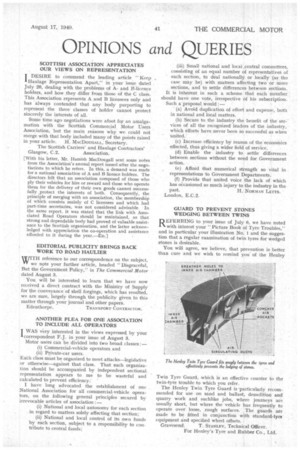OPINIONS and QUERIES
Page 41

If you've noticed an error in this article please click here to report it so we can fix it.
SCOTTISH ASSOCIATION APPRECIATES OUR VIEWS ON REPRESENTATION
IDESIRE to commend the leading article " Keep Haulage Representation Apart," in your issue dated July 20, dealing with the problems of Aand B-licence holders, and how they differ from those of the C class. This Association represents A and B licensees only and has always contended that any body purporting to represent the three classes of holder cannot protect sincerely the interests of all.
Some time ago negotiations were afoot for an amalgamation with the Scottish Commercial Motor Users Association, but the main reasons why we could not merge with that body included many of the points raised in your article. H. MACDOUGALL, Secretary.
The Scottish Carriers' and Haulage Contractors' Glasgow, C.2. Association.
[With his letter, Mr. Harnish MacDougall sent some notes from the Association's annual report issued after the negotiations to which he refers. In this, a demand was made for a national association of A and B licence holders. The directors felt that an association composed of those who ply their vehicles for hire or reward and those who operate them for the delivery of their own goods cannot successfully protect the interests of both. Consequently, the principle of merging with an association, the membership of which consists mainly of C licensees and which had part-time secretaries, was not considered advisable. In the same report, it was stated that the link with Associated Road Operators should be maintained, as that strong and dependable body had proved of valuable assistance to the Scottish organization, and the latter acknowledged with appreciation the co-operation and assistance afforded to it during the year.—En.]
EDITORIAL PUBLICITY BRINGS BACK WORK TO ROAD HAULIER
WITH reference to our correspondence on the subject, TV we note your further article, headed "Disgraceful, But the Government Policy," in The Commercial Motor dated August 3.
You will be interested to learn that we have now received a direct contract with the Ministry of Supply for the conveyance of shell forgings, which has resulted, we are sure, largely through the publicity given to this matter through your journal and other papers.
Edenthorpe. TRANSPORT CONTRACTOR.
ANOTHER PLEA FOR ONE ASSOCIATION TO INCLUDE ALL OPERATORS
I WAS very interested in the views expressed by your correspondent F.J. in your issue of August 3.
Motor users can be divided into two broad classes :— (i) Commercial-vehicle operators and (ii) Private-car users.
Each class must be organized to meet attacks—legislative or otherwise—against that class. That such organization should be accompanied by independent sectional representation appears to me to be wasteful and calculated to prevent efficiency.
I have long advocated the establishment of one National Association for all commercial-vehicle operators, on the following general principles secured by irrevocable articles of association :— (i) National and local autonomy for each section in regard to matters solely affecting that section; (ii) National and local control of its own funds by each section, subject to a responsibility to contribute to central funds; (iii) Small national and local .central committees, consisting of an equal number of representatives of each section, to deal nationally or locally (as the case may be) with matters affecting two or more sections, and to settle differences between sections. It is inherent in such a scheme that each member should have one vote, irrespective of his subscription. Such a proposal would : — (a) Avoid duplication of effort and expense, both in national and local matters.
(b) Secure to the industry the benefit of the services of all the recognized leaders of the industry, which efforts have never been so successful as when united.
(c) Increase efficiency by reason of the 'economies effected, thus giving a wider field of service.
(d) Enable the industry to settle differences between sections without the need for Government action.
(e) Afford that numerical strength so vital in representations to Government Departments.
(f) Provide that united voice the lack of which has occasioned so much injury to the industry in the past. H. NORMAN LETTS. London, E.C.2.
GUARD TO PREVENT STONES WEDGING BETWEEN TWINS
DEFERRING to your issue of July 6, we have noted " N. with interest your "Picture Book of Tyre Troubles," and in particular your illustration No. 1 and the suggestion that a regular examination of twin tyres for wedged stones is desirable.
You will agree, we believe, that prevention is better than cure and we wish to remind you of the Henley Twin Tyre Guard, which is an effective counter to the twin-tyre trouble to which you refer.
The Henley Twin Tyre Guard is 'particularly recommended for use on sand and ballast, demolition and quarry work and suchlike jobs, where journeys are usually short, but where the vehicle has frequently to operate over loose, rough surfaces. The guards are made to be fitted in conjunction with standard-tyre equipment and specified wheel offsets.
Gravesend. T. STANLEY, Technical Officer,
For Henley's Tyre and Rubber Co., Ltd.




























































